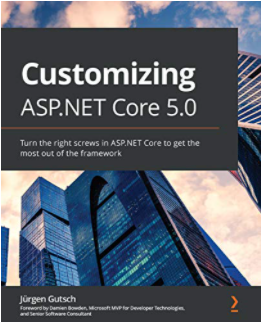Customizing ASP.NET Core Part 11: WebHostBuilder
Jürgen Gutsch - 30 January, 2019
Update 2021-02-01
This series is pretty much outdated!
As asked by a reader, I compiled the entire series into a book and updated the contents to the latest version of ASP.NET Core. This book is now ready to get ordered on Amazon:
Read here to learn more about the book
In my post about Configuring HTTPS in ASP.NET Core 2.1, a reader asked how to configure the HTTPS settings using user secrets.
"How would I go about using user secrets to pass the password to
listenOptions.UseHttps(...)? I can't fetch the configuration from withinProgram.csno matter what I try. I've been Googling solutions for like a half hour so any help would be greatly appreciated." https://github.com/JuergenGutsch/blog/issues/110#issuecomment-441177441
In this post I'm going to answer this question.
This series topics
- Customizing ASP.NET Core Part 01: Logging
- Customizing ASP.NET Core Part 02: Configuration
- Customizing ASP.NET Core Part 03: Dependency Injection
- Customizing ASP.NET Core Part 04: HTTPS
- Customizing ASP.NET Core Part 05: HostedServices
- Customizing ASP.NET Core Part 06: Middlewares
- Customizing ASP.NET Core Part 07: OutputFormatter
- Customizing ASP.NET Core Part 08: ModelBinders
- Customizing ASP.NET Core Part 09: ActionFilter
- Customizing ASP.NET Core Part 10: TagHelpers
- customizing ASP.NET Core Part 11: WebHostBuilder - This article
- customizing ASP.NET Core Part 12: Hosting - This article
WebHostBuilderContext
It is about this Kestrel configuration in the Program.cs. In that post I wrote that you should use user secrets to configure the certificates password:
public class Program
{
public static void Main(string[] args)
{
CreateWebHostBuilder(args).Build().Run();
}
public static IWebHostBuilder CreateWebHostBuilder(string[] args) =>
WebHost.CreateDefaultBuilder(args)
.UseKestrel(options =>
{
options.Listen(IPAddress.Loopback, 5000);
options.Listen(IPAddress.Loopback, 5001, listenOptions =>
{
listenOptions.UseHttps("certificate.pfx", "topsecret");
});
})
.UseStartup<Startup>();
}
The reader wrote that he couldn't fetch the configuration inside this code. And he is true, if we are only looking at this snippet. You need to know that the method UseKestrel() is overloaded:
.UseKestrel((host, options) =>
{
// ...
})
This first argument is a WebHostBuilderContext. Using this you are able to access the configuration.
So lets rewrite the lambda a little bit to use this context:
.UseKestrel((host, options) =>
{
var filename = host.Configuration.GetValue("AppSettings:certfilename", "");
var password = host.Configuration.GetValue("AppSettings:certpassword", "");
options.Listen(IPAddress.Loopback, 5000);
options.Listen(IPAddress.Loopback, 5001, listenOptions =>
{
listenOptions.UseHttps(filename, password);
});
})
In this sample I chose to write the keys using the colon divider because this is the way you need to read nested configurations from the appsettings.json:
{
"AppSettings": {
"certfilename": "certificate.pfx",
"certpassword": "topsecret"
},
"Logging": {
"LogLevel": {
"Default": "Warning"
}
},
"AllowedHosts": "*"
}
You are also able to read from the user secrets store with this keys:
dotnet user-secrets init
dotnet user-secrets set "AppSettings:certfilename" "certificate.pfx"
dotnet user-secrets set "AppSettings:certpassword" "topsecret"
As well as environment variables:
SET APPSETTINGS_CERTFILENAME=certificate.pfx
SET APPSETTINGS_CERTPASSWORD=topsecret
Why does it work?
Do you remember the days back where you needed to configure app configuration in the Startup.cs ASP.NET Core? That was configured in the constructor of the Startup class and looked similar like this, if you added user secrets:
var builder = new ConfigurationBuilder()
.SetBasePath(env.ContentRootPath)
.AddJsonFile("appsettings.json")
.AddJsonFile($"appsettings.{env.EnvironmentName}.json", optional: true);
if (env.IsDevelopment())
{
builder.AddUserSecrets();
}
builder.AddEnvironmentVariables();
Configuration = builder.Build();
This code now is wrapped inside the CreateDefaultBuilder Method (see on GitHub) and looks like this:
builder.ConfigureAppConfiguration((hostingContext, config) =>
{
var env = hostingContext.HostingEnvironment;
config.AddJsonFile("appsettings.json", optional: true, reloadOnChange: true)
.AddJsonFile($"appsettings.{env.EnvironmentName}.json", optional: true, reloadOnChange: true);
if (env.IsDevelopment())
{
var appAssembly = Assembly.Load(new AssemblyName(env.ApplicationName));
if (appAssembly != null)
{
config.AddUserSecrets(appAssembly, optional: true);
}
}
config.AddEnvironmentVariables();
if (args != null)
{
config.AddCommandLine(args);
}
})
It is almost the same code and it is one of the first things that gets executed when building the WebHost. It needs to be one of the first things because the Kestrel is configurable via the app configuration. Maybe you know that you are able to specify ports and URLs and so on using environment variables or the appsettings.json:
I found this lines in the WebHost.cs:
builder.UseKestrel((builderContext, options) =>
{
options.Configure(builderContext.Configuration.GetSection("Kestrel"));
})
That means you are able to add this lines to the appsettings.json to configure Kestrel endpoints:
"Kestrel": {
"EndPoints": {
"Http": {
"Url": "http://localhost:5555"
}}}
Or to use environment variables like this to configure the endpoint:
SET KESTREL_ENDPOINTS_HTTP_URL=http://localhost:5555
Also this configuration isn't executed
Conclusion
Inside the Program.cs you are able to use app configuration inside the lambdas of the configuration methods, if you have access to the WebHostBuilderContext. This way you can use all the configuration you like to configure the WebHostBuilder.
I just realized that this post could be placed between Customizing ASP.NET Core Part 02: Configuration and Customizing ASP.NET Core Part 04: HTTPS. So I made this the eleventh part of the Customiting ASP.NET Core Series.

